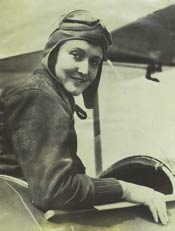|
Besides being a pilot and Register signer, Aline Rhonie was an artist from an early age. She was encouraged by her grandmother to sketch. She began formal art lessons at age fourteen with John Sloan (d. 1951), a major force in the Ashcan School. Probably because of Sloan's influence (he was a fan of Diego Rivera), Rhonie studied fresco (right sidebar) techniques with Rivera in Mexico during1934 for a duration estimated (depending on your source) from six weeks to a few months. She returned to New York and began the artwork that she is most famous for.
Every artist should have an opus magnum. Hers began when Rhonie returned from her study with Rivera, she requested and obtained a commission to paint a fresco mural on the north brick wall of Roosevelt Field Hangar F. The mural commemorates the history of aviation from 1908 to 1927, ending with Lindbergh's trans-Atlantic flight.
Again, depending upon which source you read, the mural was 106 feet by 12.5 feet, or 135 by 15. According to one source, the mural depicts, "... 500 air notables, including many of the early female aviators, 200 lesser-known personalities, and 268 planes and hangers from the pre-Lindbergh era of American aviation." Another agrees with the number of notables, but it cites 260 types of aircraft.
Regardless, it was very large and between 1935 and 1938 Rhonie worked daily to craft the mural. It is difficult to present a sense of the immensity of her mural on a Web page. Below are ten black and white and color images of sections of the mural and related documents, as well as images of her at work.
CREATING THE MURAL
The production of Rhonie's mural took about four years. There were big plans for the mural, as well as for the building in which it was housed. This article from the New York Times of December 28, 1936 describes plans for a national museum of aviation to be centered on Hangar F. Artist Rhonie would have been about half-way finished with her work on this date.
New York Times, December 28, 1936 (Hofheimer Family)
 |
Despite the prestigious members of the American Legion post listed in the article (many are Register pilots), the museum was not developed, the airport property was converted to commercial uses and the mural was removed from the wall of Hangar F in 1960. It wasn't until almost 40 years later, according to the New York Times of May 2, 1997, that "The Cradle of Aviation Museum" in East Garden City, L.I., NY, conceived of in the 1970s, finally broke ground on May 1, 1997 at the site of the old Mitchel Field. The Museum opened in 2002. Rhonie's mural, however, remains in storage to this day.
In order to appreciate the magnitude of her work, below are two images of Rhonie on the wooden scaffolding that was constructed. The scaffold clearly was required to reach the levels on the hangar wall where the fresco was applied.
Aline Rhonie on Scaffolding, Ca. 1934-38 (Source: Hofheimer Family)
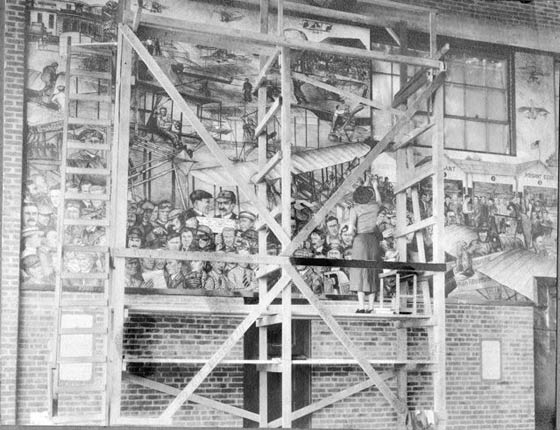 |
If you compare her size with some of her images in the foreground of her work, you can see that some of the characters are life-size or larger. Another view of her working on the scaffold is at the link.
Aline Rhonie on Scaffolding, Ca. 1934-38 (Source: Hofheimer Family)
 |
The light shapes on the photo below are from the effects on the photo emulsion of glue on the back of the photo. Note the airplane on the right.
Aline Rhonie on Scaffolding, Ca. 1934-38 (Source: Hofheimer Family)
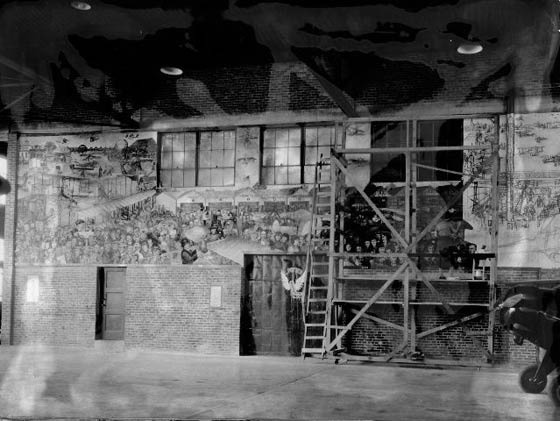 |
A few status updates on mural progress were published in the New York Times. One, from December 26, 1937, was written by Register pilot and journalist James Piersol.
WHAT THE MURAL LOOKED LIKE
Besides the black and white photo above that gives a hint of the size, a color postcard of one section of the mural is found in Rhonie's Collection at her CERTIFICATES AND CARDS section. Other color and black & white images of the mural are at the link.
It is difficult to present a sense of the immensity of her mural on a Web page. Below is my attempt to do that from a multiple page spread in the New York Mirror Magazine of November 20, 1960. In its day, it must have been a huge splash of color in an otherwise workaday hangar.
Rhonie Mural, 1960 (Source: Hofheimer Family)
 |
An important piece of documentation regarding the mural is available as a PDF download (32MB). This 25-page booklet exhibits drawings of the entire mural which are keyed numerically to the names of people and aircraft depicted. It is a very valuable "map" of the mural.
For example, below is a black and white image of the section from the mural titled "WWI Period". Again, the mottled appearence throughout this photograph is due to the long-term effects on the photo emulsion of the adhesive that held the photograph in Rhonie's album.
Rhonie Mural, WWI Period (Source: Hofheimer Family)
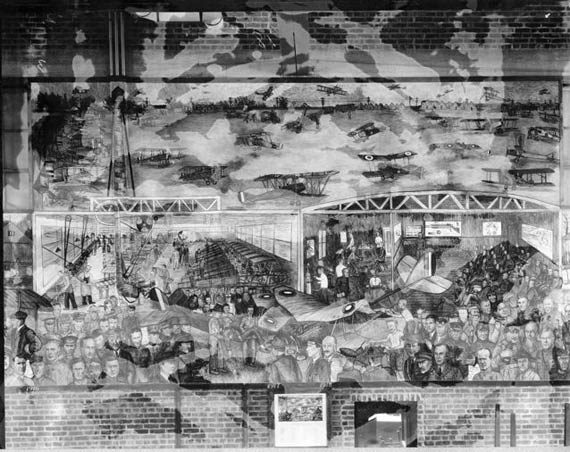 |
Below, a small color section of the mural photograph above. The colors are vivid. Compare the position of this section in the full-length representation just above.
Rhonie Mural, Color Section, WWI Period (Source: Hofheimer Family)
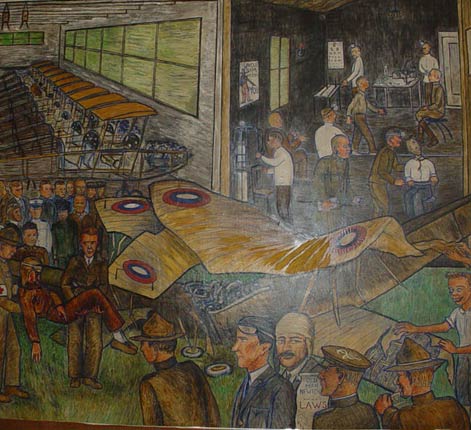 |
Below is a three-page spread from the booklet, keyed to the people and aircraft. The entire mural is thus represented. Across pages 2-3 of the booklet the entire expanse of the mural is shown. Not much detail is visible, but the aesthetic balance of the work is clearly represented.
This particular page of the brochure is keyed to the photographs above. Note the pilot identified as #37, just below the crumpled wings of the DeHavilland (#34). He is M. Tabuteau, a French airman who, according to the New York Times of October 5, 1919, "... Made a splendid flight over the Pyrenees from Spain to France last evening." You can identify other pilots and aircraft keyed to the pages below.
Rhonie Mural "Map", WWI Period (Source: Hofheimer Family)
 |
Rhonie Mural "Map", WWI Period (Source: Hofheimer Family)
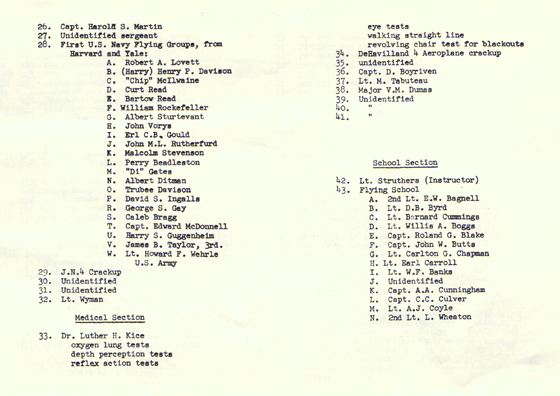 |
Also of interest on this section of the mural is the name of Victor W. Pagé (#7 in the lower section). During the late 1920s and into the 1930s, Pagé published a series of books on aircraft maintenance and design. His books were valuable additions to the libraries of mechanics, pilots and flight students. There are many, many Register personalities represented across the mural, including Tex LaGrone, Charles Lindbergh, C.C. Moseley, Horace Heisen and Russell Maughan.
Rhonie traveled to Ireland near the end of her work on her mural. Below, pages 1 & 4 of a Roosevelt Field News, which mentions Rhonie and her mural on page 4 (this single-fold 11" x 17" document was scanned flat, so you see pp. 1 & 4 and 2 & 3 below). I exhibit the document vertically for better text size. She had just returned from Ireland where she acquired her Irish transport license.
Roosevelt Field News, April 26,1938 (Source: Hofheimer Family)
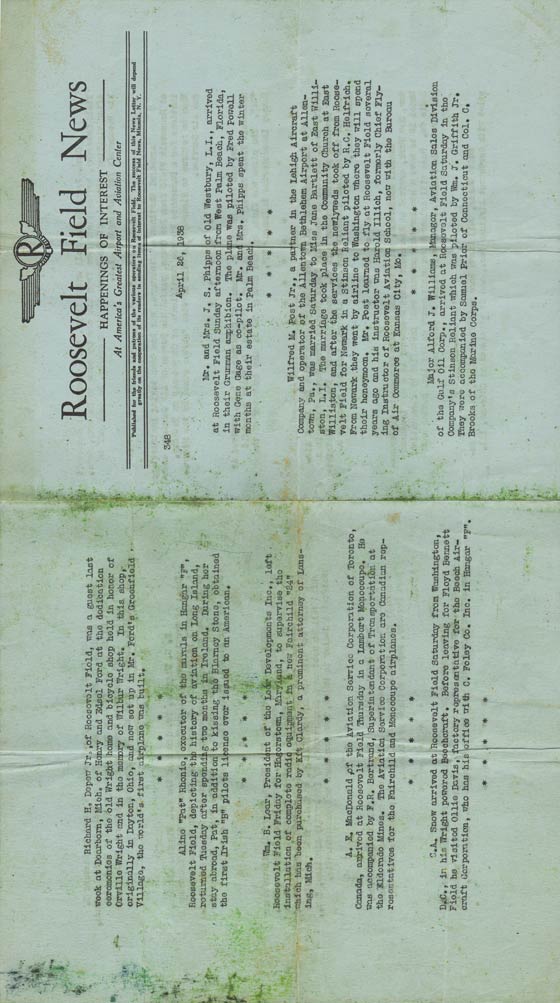 |
An interesting thing about this newsletter is the number of Register pilots and passengers it cites besides pilot Rhonie. Among them are Richard Depew, William B. Lear, Frank Hawks and Nancy (Harkness) Love.
Roosevelt Field News, April 26,1938 (Source: Hofheimer Family)
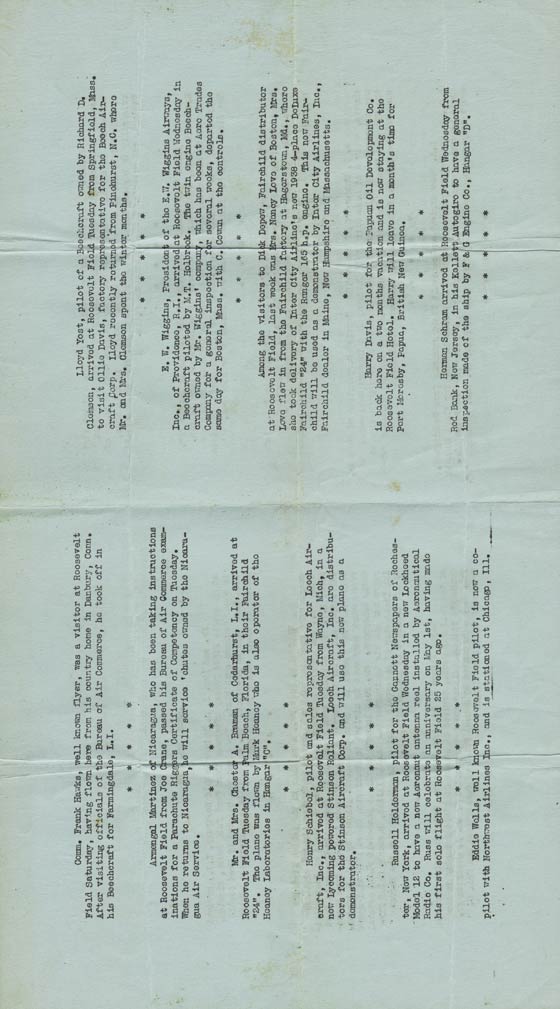 |
With her return to the U.S. in April, and the completion of her mural, the formal debut was scheduled.
MURAL DEBUT
After her mural was completed, there was an artist's reception and party on October 15, 1938. Below, the invitation to the party. The original invitation is about 3" x 5".
Party Invitation Celebrating Completion of the Mural, October 15, 1938 (Source: Hofheimer Family)
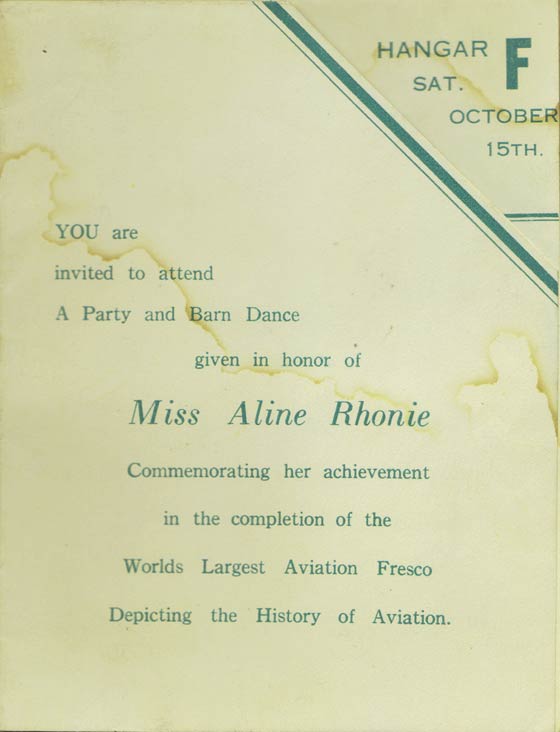 |
Below, music was provided by "A" Roger Wolfe Kahn Orchestra. "The" Roger Kahn's orchestra was active during the 1920s and early 30s. It was disbanded in 1933 when Kahn became a test pilot for Grumman Aircraft on Long Island. "A" Roger Wolfe Kahn Orchestra might mean a tribute-type band, or it may mean that Rhonie was able to use her pilot network to coax Kahn to form a band to back "Gamboling at its Best" during this special occasion. Either way, the band would be a jazz band. Kahn and his band were well-known and have a good Web presence, including mp3 recordings.
Party Invitation Celebrating Completion of the Mural, October 15, 1938 (Source: Hofheimer Family)
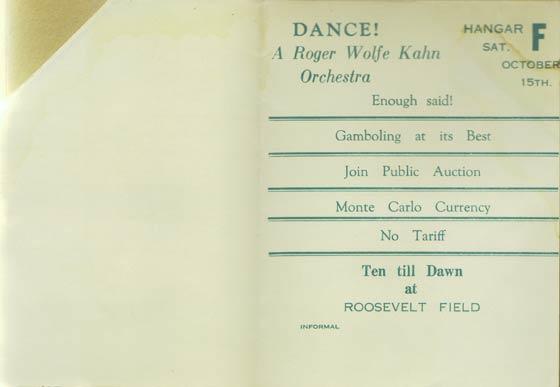 |
The New York Times of October 17, 1938 states, "The fresco was unveiled at a party on Saturday night, atended by more than 500 guests. This all-night party, with informal dress, was probably THE event for October at Roosevelt Field.
FATE OF THE MURAL
Few foresaw the changes that would take place in the area around Roosevelt Field on Long Island over the next decade after Rhonie completed her mural. Roosevelt Field was heavily used by the military during WWII. After that, the land, very near to New York City, became valuable for real estate development, industry and commerce. Long story short, it closed as an airport May 31, 1951, just 13 years after "Gamboling at its Best."
New York Times, March 5, 1953
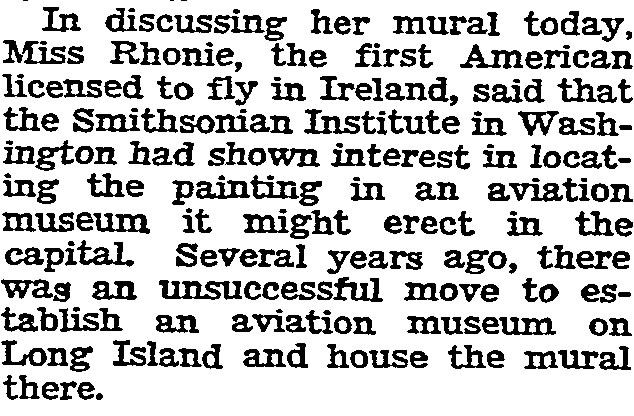 |
What to do about the mural? The old Hangar F was allowed to deteriorate. Later in the 1950s, it was used for storage, with materials and goods stacked within inches of the fragile mural surfaces. As early as 1953, Rhonie began to think about the logistical and cash requirements of preserving or moving it. The quote at left from the New York Times suggests that the Smithsonian was interested in having the mural. This did not come to pass when the National Air & Space Museum was finally opened in the mid-1970s.
In the download cited above you will learn that Rhonie consulted with an Italian fresco preservationist, Leonetto Tintori. The New York Times of September 9, 1960 documented the visit by Tintori. His consulting fee was $18,000 (however, estimates ranged from near $13,000 to over $100,000, depending upon which source you read). Finally, in late 1960, Tintori removed the mural from the north wall of Hangar F.
Removed Section of Mural, NY Mirror Magazine, November 20, 1960 (Source: Hofheimer Family)
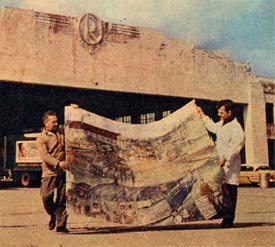 |
During the removal, the New York World World Telegram and Sun reported on Monday December 5, 1960, "Miss Rhonie, who painted the mural from 1935-38 to show 19 years of the history of American flying, watched quietly yesterday. The hangar is now a Railway Express warehouse, and workers there occasionally stopped to watch and wonder. 'I feel as thought they're taking my skin off,' Miss Rhonie said. 'But I have complete confidence in Prof. Tintori.' She said that the secret of the process 'is in the glue' -- which is cooked in the double boiler." The skin metaphor is not out of place, as shown in the photo at right from the 1960 NY Mirror Magazine.
Tintori's methodology is described in the PDF. The mural is presently in sections and in storage at a college on Long Island. It needs a home where it can be restored to its original colorful historic statement.
OTHER ARTS
Artist Rhonie's albums contain several news articles and advertisements that announce her formal exhibitions and that identify galleries in which her work was displayed. Most of these were in the greater New York metropolitan area. Below, a 1954 Holiday Season exhibition in Manhattan is documented in a bifold brochure.
Exhibit Brochure, December 9-24, 1954 (Source: Hofheimer Family)
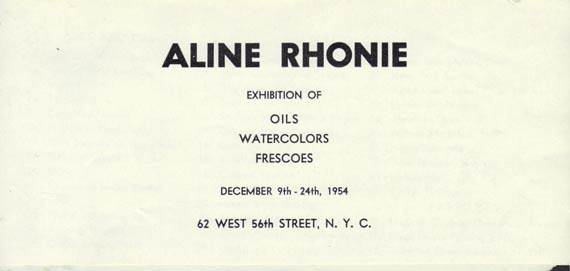 |
Exhibit Brochure, December 9-24, 1954 (Source: Hofheimer Family)
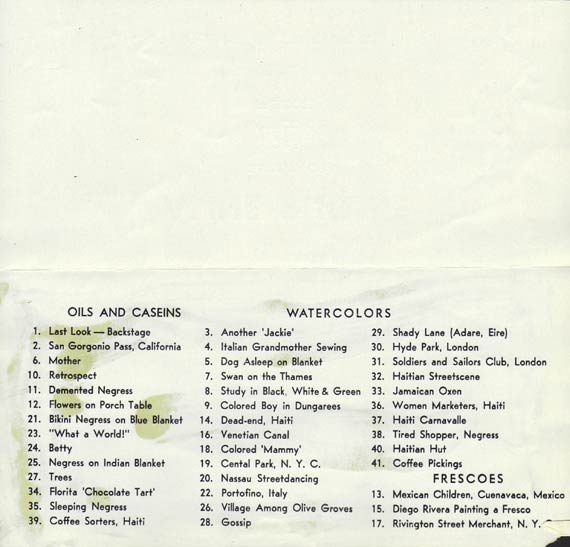 |
---o0o---
Of 42 female pilots who signed the Davis-Monthan Register, Aline "Pat" Rhonie combines the good traits of many of her sister signers. She ranks high among her sisters in hours and miles flown throughout her life in aviation. She stands out in her humanitarian activities on behalf of the French and British just before the outbreak of WWII. She was a member of the WAFS and the WASP.
Across two decades she received awards and certificates of appreciation from the French and United States governments. She held and mutually respected a wide network of friends, among them some of the movers and shakers of Golden Age aviation. She was a fine artist of considerable repute, who has a robost Web presence in that area to this day.
She signed the Register once in 1934 on Tuesday, March 20th. Please refer to her biographical link, above, for details on that landing, including the airplane she flew and the circumstances of her voyage.
Unless otherwise noted, these images were scanned at 300dpi.
Please note also: other than cropping, sizing and optimizing
the images for web display, they are unretouched in any way.
Most of them are published nowhere else but here at www.dmairfield.org. The images are displayed without much technical commentary.
Rather, the links will take you to further information, where
available.
---o0o---
THIS PAGE UPLOADED: 12/11/10 REVISED:
|

